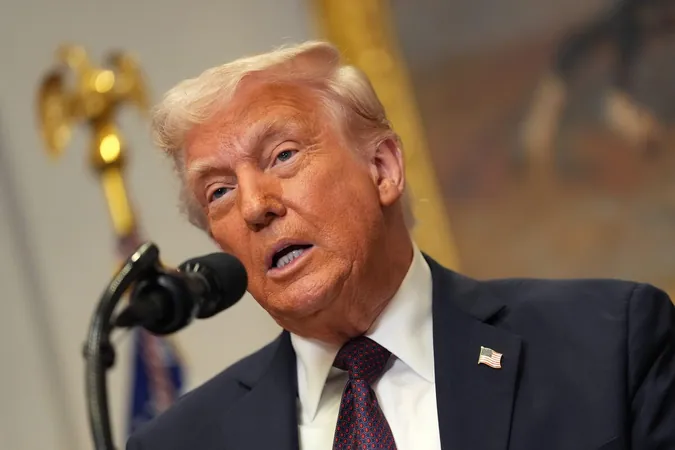
Trump Plans Major Tariff Announcements on Vehicles and Pharmaceuticals: What You Need to Know!
2025-03-24
Author: Sophie
In a statement on Monday, U.S. President Donald Trump hinted at imminent tariff announcements on vehicles and pharmaceuticals, but left the exact timing unclear. The administration is set to implement what they describe as "reciprocal" tariffs on April 2, targeting trading partners, even though it's uncertain whether these sector-specific duties will coincide with that date.
Throughout the past month, speculation swirled regarding potential tariffs on industries such as automobiles. Reports from Bloomberg and the Wall Street Journal suggest the administration might delay these sector-specific measures while still keeping them in play, which contributed to a positive shift in stock markets on Monday.
These forthcoming "reciprocal" tariffs are poised to become the cornerstone of Trump’s assertive trade strategy, seemingly replacing his previous pledge for a blanket tariff on all trading partners. However, significant questions loom regarding how these tariffs will be calculated, implemented, and which specific countries will face them.
During a recent cabinet meeting, Trump reiterated his belief that the U.S. has been "ripped off" by various countries, both allies and adversaries. He pointed to Canada's substantial goods trade surplus with the U.S. last year, primarily attributed to oil exports, while overall trade balances shift when services are included.
Emerging details hint that Treasury Secretary Scott Bessent may propose country-specific tariff rates designed to counter the tariffs imposed by other countries on U.S. goods, as well as to address additional trade grievances. He mentioned a group of countries referred to as the "dirty 15," which likely includes Canada, that have significant trade surpluses with the U.S.
It's noteworthy that Canada’s average effective tariff on U.S. imports hovers around 2 percent, suggesting that reciprocal tariffs based solely on customs duties would remain relatively modest. However, the Trump administration has indicated that additional issues—like Canada’s digital services tax and its management of dairy and poultry products—might escalate the overall tariff rates.
In an expansion of trade tensions, Trump also announced plans to impose a hefty 25 percent tariff on countries that import oil and gas from Venezuela, effective April 2. He justified this move by accusing Venezuela of "purposefully and deceitfully" sending criminals to the U.S. Countries like China, India, and Spain that import Venezuelan crude could find themselves facing these tariffs.
Additionally, Commerce Secretary Howard Lutnick mentioned that the White House plans to introduce the "external revenue service," a new agency aimed at collecting tariffs and other revenues from foreign entities, starting April 2.
Since taking office, Trump’s trade policy has been marked by both aggression and unpredictability. On March 4, he introduced a 25 percent tariff on imports from Canada and Mexico (with a 10 percent tariff on energy products), linking the tariffs to U.S. border security concerns. However, only two days later, he offered a temporary reprieve to products compliant with the United States-Mexico-Canada Agreement (USMCA), signaling the complexities of his approach.
Trump has not shied away from deriding Canada’s auto industry, claiming that the U.S. doesn’t need cars produced there. Following a controversy over Ontario’s export surcharge on electricity, he even threatened to “permanently shut down the automobile manufacturing business in Canada.”
In 2023, Ontario plants operated by major automakers like Ford, GM, Stellantis, Honda, and Toyota produced approximately 1.5 million vehicles, with a staggering 93 percent destined for the U.S. market. Furthermore, on March 12, Trump imposed a 25 percent tariff on steel and aluminum imports, which also affects Canadian goods.
In retaliation, Canada has implemented its own tariffs on about $60 billion worth of U.S. goods, warning of further measures if the U.S. does not reverse its policies. As these developments unfold, businesses on both sides of the border are anxiously awaiting the outcomes of these proposed tariffs and the inevitable impact on the economy.
Stay tuned as we continue to monitor this situation!









 Brasil (PT)
Brasil (PT)
 Canada (EN)
Canada (EN)
 Chile (ES)
Chile (ES)
 Česko (CS)
Česko (CS)
 대한민국 (KO)
대한민국 (KO)
 España (ES)
España (ES)
 France (FR)
France (FR)
 Hong Kong (EN)
Hong Kong (EN)
 Italia (IT)
Italia (IT)
 日本 (JA)
日本 (JA)
 Magyarország (HU)
Magyarország (HU)
 Norge (NO)
Norge (NO)
 Polska (PL)
Polska (PL)
 Schweiz (DE)
Schweiz (DE)
 Singapore (EN)
Singapore (EN)
 Sverige (SV)
Sverige (SV)
 Suomi (FI)
Suomi (FI)
 Türkiye (TR)
Türkiye (TR)
 الإمارات العربية المتحدة (AR)
الإمارات العربية المتحدة (AR)